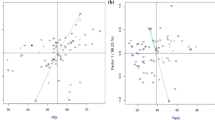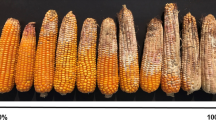Abstract
Fusarium stalk rot disease (FSR) of maize caused by Fusarium verticillioides (Sacc.) Nirenberg is becoming an important biotic production constraint in many of the major maize growing areas causing substantial yield losses. Inbreds are preferred as parents in hybrid development owing to homozygous nature and high heterotic ability. Double haploid (DH) technology has emerged as a significant milestone. A total of 339 DH lines were generated from two inbred lines, VL1043 (susceptible) and CM212 (resistant), through in vivo haploid induction method. The 339 DH lines along with parents were phenotyped for their response to the FSR at the College of Agriculture, V. C. Farm, Mandya, India during summer, kharif and rabi seasons of the 2019–2020. Best linear unbiased predictors (BLUPs) were estimated for the FSR disease scores over three seasons. A wide range of BLUP scores of three to nine indicated the presence of higher variation for response of DH lines to FSR disease. The higher estimates of standardized range (1.31) and phenotypic coefficient of variation (19.80) also displayed higher variability. Nine lines were moderately resistant and 188 exhibited moderately susceptible reaction. The distribution of DH lines was positively skewed (1.34) and platykurtic (2.31) which suggested complementary epistasis and involvement of large number of genes in the disease expression.

Similar content being viewed by others
References
Archana R., Lohithaswa H. C., Uma M. S., Shivakumar K. V., Sanathkumar V. B. and Pavan R. 2019 Genetic analysis of Fusarium stalk rot resistance in maize (Zea mays L). J. Pharmacognosy Phytochem. SP1, 58–61.
Burton G. W. and DeVane E. M. 1953 Estimating heritability in tall Fescue (Festuca circunelinaceae) from replicated clonal material. J. Agron. 45, 478–481.
Chaikam V., Molenaar W., Melchinger A. E. and Prasanna B. M. 2019 Doubled haploid technology for line development in maize: technical advances and prospects. Theor. Appl. Genet. 132, 3227–3243.
Choo T. M. and Reinbergs E. 1982 Analysis of skewness and kurtosis for detecting gene interaction in a double haploid population. Crop Sci. 22, 231–235.
Cook R. J. 1978 The incidence of stalk rot (Fusarium spp.) on maize hybrids and its effect on yield of maize in Britain. Ann. Appl. Biol. 88, 23–30.
Desai S., Hegde R. K. and Desai S. 1991 A preliminary survey of incidence of stalk rot complex of maize in two districts of Karnataka. Indian Phytopathol. 43, 575–576.
Federer W. T. 1961 Augmented design with one-way elimination of heterogeneity. Biometrics 17, 447–473.
Fisher F. A., Immer F. R. and Tedin O. 1932 The genetical interpretation of statistics of the third degree in the study of quantitative inheritance. Genetics 17, 107–124.
Harlapur S. I., Wali M. C., Prashanth M. and Shakuntala N. M. 2002 Assessment of yield losses in maize due to charcoal rot in Ghataporabha Left Bank Cannal (GLBC) command area of Karnataka. Karnataka J. Agric. Sci. 15, 590–591.
Hooker A. L. 1956 Association of resistance to several seedling, root, stalk, and ear diseases of corn. Phytopathology 46, 379–384.
Johnson H. W., Robinson H. F. and Comstock R. E. 1955 Estimates of genetic and environmental variability in soybean. Agron. J. 47, 314–318.
Kenganal M., Patil M. B. and Nimbarag Y. 2017 Management of stalk rot of maize caused by Fusarium moniliforme (Sheldon). Int. J. Curr. Microbiol. App. Sci. 6, 3546–3552.
Kimbeng C. A. and Bingham E. T. 1998 Population improvement in Lucerne (Medicago sativa L.): components of inbreeding depression are different in original and improved populations. Aust. J. Exp Agric. 38, 831–836.
Kumar M., Lal H. C. and Jha M. M. 1998 Assessment of yield loss due to post-flowering stalk rots in maize. J. Appl. Biol. 8, 90–92.
Lush J. L. 1945 Heritability of quantitative characters in farm animals. Proc. 8th Genetics Congress. Hereditas 35, 356–375.
Mohamed H. A., Moneim A. T. A. and Fathi S. M. 1966 Reaction of corn inbred lines, varieties and hybrids to four fungi causing stalk rots. Plant Dis. Rep. 50, 401–402.
Nirenberg H. 1976 Untersuchungen iiber die morphologische und biologische Differenzierung in der Fusarium Sektion Liseola. Mitt. Biol. Bund. Anst. Ld-u. Forstw. 169.
Payak M. M. and Sharma R. C. 1983 Disease rating scale in Maize in India. Techniques of scoring for resistance to important diseases of maize. All India Coordinated Maize Improvement Project, pp 1–5. IARI, New Delhi.
Pooni H. S., Jinks J. L. and Cornish M. A. 1977 The causes and consequences of non-normality in predicting the properties of recombinant inbred lines. Heredity 38, 329–338.
Prasanna B. M., Chaikam V. and Mahuku G. 2012 Doubled haploid technology in maize breeding: theory and practice. CIMMYT, Mexico.
Robinson H. F., Comstock R. E. and Harney P. H. 1949 Estimates of heritability and degree in corn. J. Agron. 41, 353–359.
Robson D. S. 1956 Application of K4 statistics to genetic variance component analysis. Biometrics 12, 433–444.
Rojas B. A. and Sprague G. F. 1952 A comparison of variance components in corn yield trials III. General and specific combining ability and their interaction with locations and years. Agron. J. 44, 462–466.
Roy D. 2000 Plant breeding—the analysis and exploitation of variability, pp. 198. Narosa Publishing House. New Delhi, India.
Shekhar M. and Sangit Kumar 2012 Inoculation methods and disease rating scales for maize diseases. Directorate of Maize Research, Indian Council of Agricultural Research, Pusa Campus, pp. 20–28. New Delhi, India.
Snape J. W. and Riggs T. J. 1975 Genetical consequences of single seed descent in the breeding self-pollinated crops. Heridity 35, 211–219.
Snedecor G. W. and Cochran W. G. 1994 Statistical methods, fifth edition. Iowa State University Press, Ames.
Sundarraj N., Nagaraj S., Venkataramu M. N. and Jagannath M. K. 1972 Design and analysis of field experiments. University of Agricultural Sciences, Bengaluru.
Xu Y., Li P., Zou C., Lu Y., Xie C., Zhang X. et al. 2017 Enhancing genetic gain in the era of molecular breeding. J. Exp. Bot. 68, 2641–2666.
Acknowledgements
Authors are thankful to the Directorate of Research, UAS, Bengaluru, India, for adequate funding and M/s Corteva Agriscience Pvt. Ltd., Gouribidanur, for generating doubled haploid lines of maize which were used in the present study. The first author acknowledges the Directorate of Minorities, Government of Karnataka, India, for providing scholarship during the course of study and to pursue the Ph.D. programme.
Author information
Authors and Affiliations
Corresponding author
Additional information
Corresponding editor: Manoj Prasad
Rights and permissions
About this article
Cite this article
Showkath Babu, B.M., Lohithaswa, H.C., Mallikarjuna, N. et al. Genetic characterization of maize doubled haploid lines for Fusarium stalk rot caused by Fusarium verticillioides. J Genet 99, 83 (2020). https://doi.org/10.1007/s12041-020-01236-4
Received:
Revised:
Accepted:
Published:
DOI: https://doi.org/10.1007/s12041-020-01236-4




